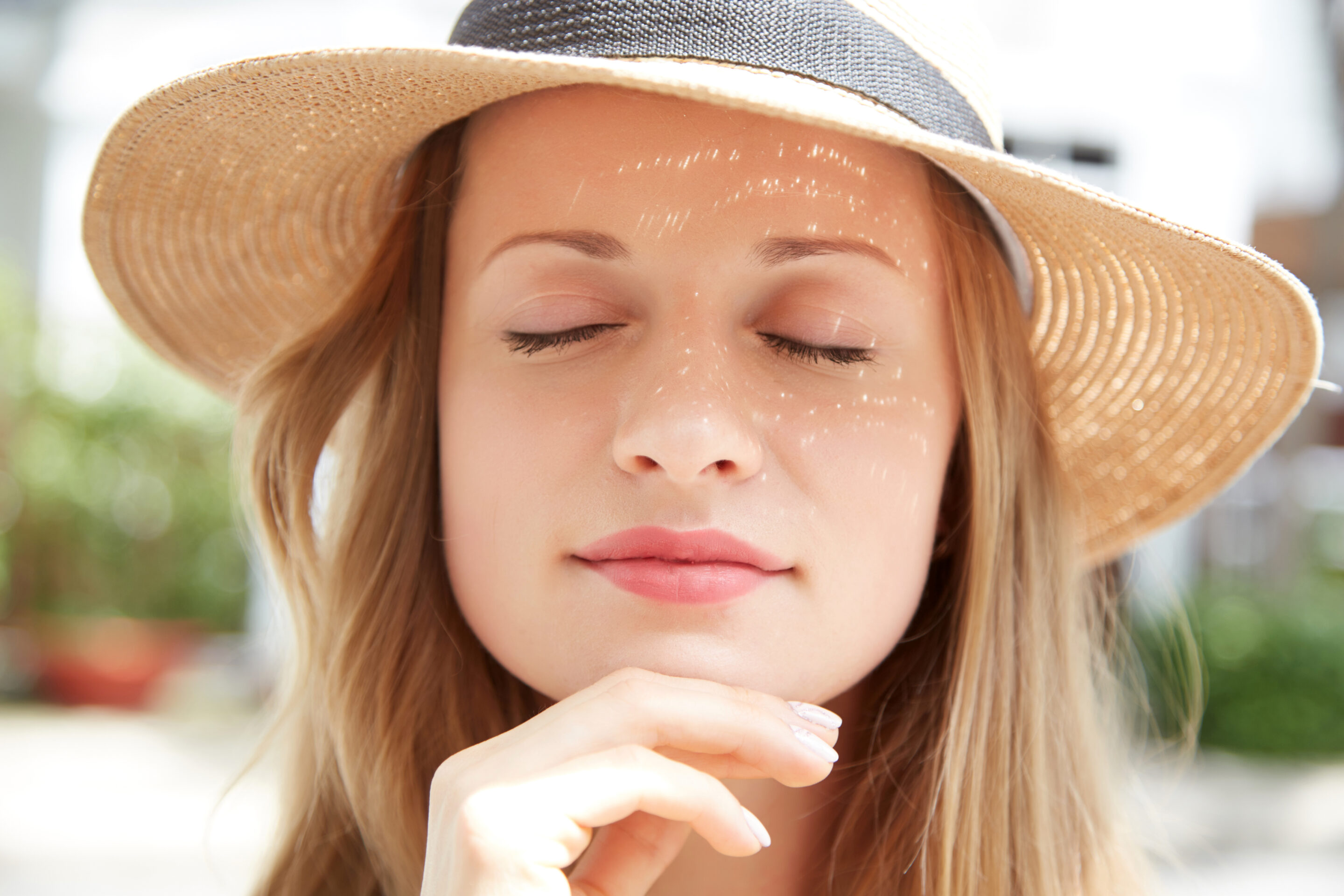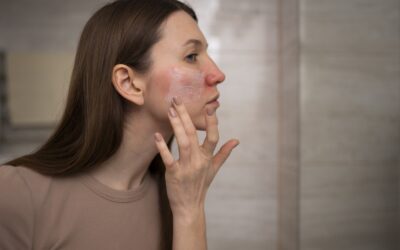Have you ever looked in the mirror and noticed dark spots on your skin, wondering whether they’re a natural sign of aging or the result of sun exposure? You’re not alone. Many people struggle to distinguish between age spots vs sun spots, yet understanding the difference is crucial for proper treatment and prevention.
What Are Age Spots and Sun Spots?
Age spots, also known as liver spots or solar lentigines, are flat, brown, or black spots that appear on the skin as we get older. Despite their other common name “liver spots,” they have nothing to do with the liver. Instead, they develop due to a combination of aging, sun exposure, and genetics.
Sun spots or Sun Damage spots (Actinic Keratoses or Seborrheic Keratosis) on the other hand, are dark patches that form specifically due to sun damage and are more raised, rough and scaly in texture. These types of marks appear on areas most exposed to the sun, such as the face, hands, shoulders, back and arms. Sun spots can develop at any age and are directly linked to UV exposure without sunscreen. They are more common in adults over 45.
Key Differences Between Age Spots and Sun Spots
The main distinction lies in their causes and development patterns. Age spots typically appear gradually over time as part of the natural aging process, though sun exposure can accelerate their formation. They tend to be smaller and more uniform in color.
Sunspots, however, can appear suddenly after intense sun exposure or develop over time with cumulative UV damage. They often vary in size and shape and may be darker or more irregular in appearance than age spots. While both types of spots are more common in people over 40, sunspots can affect younger individuals who spend significant time in the sun without proper sunscreen use.
Advanced Treatment Options for Non-raised spots: IPL and Alexandrite Laser
Modern laser aesthetics offers several effective treatments for both age spots and sun spots. Two of the most popular and successful options are Intense Pulsed Light (IPL) and Alexandrite laser treatments, which work well for lesions that are not raised.
Intense Pulsed Light (IPL)
IPL therapy uses broad-spectrum light to target pigmented areas while leaving surrounding tissue unaffected. The light energy breaks down melanin clusters, allowing the body to naturally remove the pigmented cells. IPL is particularly effective for treating:
- Larger areas of pigmentation
- Multiple spots simultaneously
- Both superficial and slightly deeper pigmentation
- Redness caused by inflammation or sun exposure
The procedure is relatively comfortable, with many describing the sensation as a mild-moderate, warm band snapping feeling against the skin.
Alexandrite Laser Treatment
The Alexandrite laser is known for its precision and effectiveness in treating stubborn pigmentation. This specific wavelength of laser light penetrates deeper into the skin than IPL, making it especially useful for:
- Darker or more resistant spots
- Deeper pigmentation
- Specific, targeted areas
The Alexandrite laser typically requires fewer sessions than IPL, with many clients seeing significant improvement after 1-2 treatments. However, the treatment can involve slightly more redness and affects in the treated spots for 1-2 weeks afterwards.
Prevention and Maintenance: Medical-Grade Skincare Solutions
While professional treatments can effectively address existing spots, it does nothing for preventing new ones from forming. This is equally important and needs to be done by the client afterwards. Medical-grade skincare products offer superior results compared to over-the-counter options due to their higher concentration of active ingredients and advanced formulations, backed by medical research studies.
Medical-Grade Mineral Sunscreen
The foundation of any pigmentation prevention routine is a high-quality mineral sunscreen. Unlike chemical sunscreens, mineral-based options containing zinc oxide and titanium dioxide provide immediate protection by physically blocking and reflecting away harmful UV rays.
For optimal protection:
- Apply generously 15-30 minutes before sun exposure
- Reapply after swimming/sweating
- Mineral sunscreen does not need to be re-applied every 2 hours like chemical sunscreen
Professional-Strength Retinol
Retinol, a vitamin A derivative, is one of the most researched and effective ingredients for preventing and treating skin pigmentation. Medical-grade retinol products offer higher concentrations and better delivery systems than their over-the-counter creams. These medical formulations will be more effective at:
- Accelerating skin cell turnover
- Regulating melanin (excessive pigment) production
- Improve overall skin texture and roughness
- Help prevent new sun and age spots from forming
Medical-Grade Vitamin C Serums
Vitamin C is a powerful antioxidant that helps protect against UV damage while brightening any existing pigmentation. Medical-grade vitamin C serums typically contain L-ascorbic acid at concentrations of 15-20%, making them significantly more effective than regular skincare products found in drug or beauty stores. These serums:
- Neutralize free radicals from UV exposure, which helps with wrinkles as well as pigmentation
- Inhibit tyrosinase, which is an enzyme involved in pigmentation production
- Provide additional protection for your skin when used under sunscreen
- Help maintain results after professional treatments
Skinceuticals Discoloration Defense
This specialized treatment serum represents the latest advancement in pigmentation prevention and treatment. Containing a blend of kojic acid, niacinamide, and tranexamic acid, Discoloration Defense targets stubborn discoloration while helping prevent new spots from forming. The product works by:
- Reducing the intensity of existing dark spots
- Evening out skin tone overall
- Preventing pigment transfer to the skin’s surface
- Supporting the skin’s natural defenses against new pigmentation
Creating an Effective Treatment Plan
The most successful approach to managing age spots and sun spots typically combines professional laser/IPL treatments with consistent use of medical-grade skincare products. Here’s a suggested plan of attack:
- Begin with a series (1-3) of IPL or Alexandrite laser treatments as recommended by your skincare professional.
- During treatments, use gentle, non-irritating skincare products, avoid retinol and use religious, daily mineral sun protection.
- Once your treatment series is complete, maintain results with a comprehensive skincare routine including:
- Morning: Gentle cleanser, vitamin C serum, Discoloration Defense, moisturizer, and mineral sunscreen
- Evening: Gentle cleanser, Discoloration Defense, retinol (alternate nights and start with only 1-2 days per week), and moisturizer
- Schedule periodic maintenance treatments as needed, typically every 12-24 months.
The Importance of Consulting with a Professional Before Laser or IPL:
While both age spots and sunspots are generally harmless, it’s crucial to have any new or changing spots evaluated by a physician. Some pigmented lesions can be signs of more serious skin conditions, including melanoma, so its best to ensure that all spots are healthy prior to removing them.


